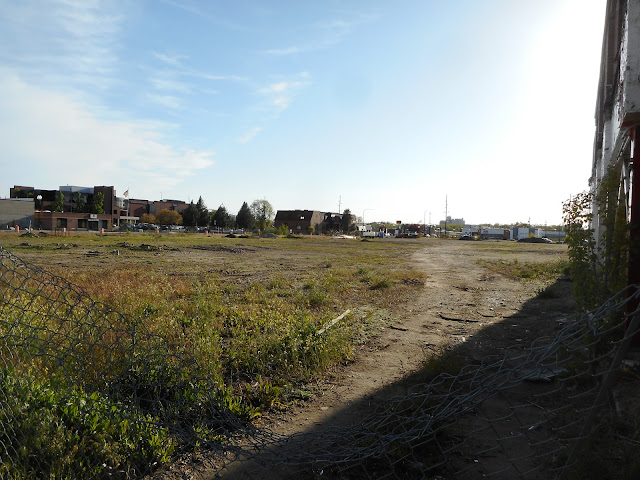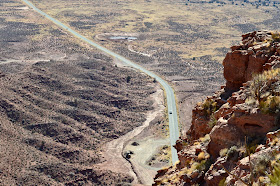View of the west end of the Duchesne Tunnel. in July, with low water levels.
(Photo by Roger Arave.)
WHEN driving along the Mirror Lake Highway (U-150), it is hard not
to look upward at the majestic Uinta Mountain Range. However, BELOW the highway
level is a feature just off the highway that most travelers miss …
The Duchesne Tunnel is a six-mile long engineering marvel
that is a key to providing water to Utah and Salt Lake counties. The tunnel
takes water the south slope of the Uinta Mountains in the Duchesne River
drainage and moves it over the mountains to the Provo River drainage and into
Deer Creek Reservoir.
This $9 million tunnel can be viewed at a stop along the
Mirror Lake Highway in summer (U-150).
The stop is signed on both the east and west ends of the
highway. However, the west sign is so close to the paved turnout, that
motorists may easily pass by and have to turn around and return.
Watch for it 0.7 of a mile after milepost No. 17, right
after the Shady Dell Campground, on the right (south) side of the road for
eastbound travelers.
Although some overgrown trees obscure a good view of it, a
100-foot-long path leads about 40 feet downward to a fenced viewpoint.
There are also several historical plaques there.
This tunnel required 13 ½ years to build. From delays over a work
strike, to World War II manpower and financial shortages, to a disastrous fire,
to another strike, this one over safety issues, this project had a lot of
obstacles.
One of the first references to the tunnel’s construction was in
the Salt Lake Tribune of May 4, 1941. “Work on the Duchesne tunnel also is
proceeding rapidly,” the story stated, explaining that 90 men working three
different shifts had hollowed out 2,000 feet of tunnel during the approximate
first year of work.
WW II temporarily halted work on the tunnel. Yet, a Salt Lake
Telegram story of Dec. 30, 1941, stated that the project “is needed to supply
additional water for defense developments in Salt Lake and Utah counties.”
Less than a year later, work on the project was at a standstill
when a fire destroyed a $100,000 power plant. Machinery and generators were
ruined and replacements had to come from San Francisco, according to the
Telegram of Oct. 20, 1942.
Next there was a wartime hiatus on work.
The Provo Daily Herald of Jan. 7, 1946 stated that wartime
restrictions had finally come to an end and tunnel work would resume soon.
The Daily Herald of June 12, 1946 stated there was a new project
problem – a cement lining in the tunnel was now deemed as necessary, raising
the total cost by at least $900,000.
Besides having another four miles to do, now the cement meant considerable
additional work.
The Herald of May 4, 1947 stated that the Bureau of Reclamation
was going to have to call for new bids to finish the remaining 3.7 miles of the
tunnel.
The Herald followed on July 3, 1947 with this headline, “Duchesne
Tunnel encounters year delay because of bid rejections, but water shortage is
not an immediate danger.”
The lowest bid received -- $2.54 million -- was one-third higher
than the engineer’s estimate.
After a suitable bid was reached and construction restarted and almost
three years later in 1951, there was a major strike over job safety. The Salt
Lake Telegram of March 21, 1951 stated that workers claimed “hazardous working
conditions” and “unreasonable demands for speed.”
Work eventually restarted, but almost six months later in October
of 1951, there were still some 3,000 feet to go in the tunnel boring. The
tunnel was extensively inspected and it was estimated that it could be ready
for use in 1952.
That estimate was wrong, because the Korean War in 1951 also halted
construction.
The Daily Herald of Dec. 6, 1951 reported the tunnel was only 217
feet short of being “holed through.” However, the tunnel was still going to
have to be lined with cement and so the completion date was being reset for
early 1953.
Workers were getting anxious for completion of the project and
they had all contributed $1 toward a pool to guess when the tunnel bore would
be completed.
Tragedy also struck in the tunnel project on July 24, 1952, when a
worker was killed on the job. Stanley M. Elder, 19, was killed when a slipped
into a sand chute and was buried under four feet of earth. The Wasatch Wave
newspaper of July 25 reported that workers saw a hand protruding from the sand
and summoned help. He was removed within five minutes, but could not be
revived.
The Ogden Standard-Examiner of Aug. 4, 1952 carried the headline,
“Crews working 3 shifts a day to complete Duchesne tunnel.” Work on lining the
tunnel walls with cement had begun June 23. “Workers are now about one-quarter
of the way into the giant tunnel and will soon be moving at a 300-foot per day
clip,” the newspaper stated.
The Salt Lake Tribune of Nov. 24, 1952 stated that cleanup work
was all that remained on what was the longest tunnel ever bored in Utah.
However, ample water supplies were likely to delay usage of the tunnel. The
last concrete in the tunnel had been poured on Nov. 10, 1952.
The Standard-Examiner reported “6-mile Duchesne tunnel is done” on
Oct. 14, 1953. Water that day was turned into the tunnel, erasing any concerns
that the Salt Lake Valley would run out of water anytime soon.
This concrete-lined tunnel is 9.2-feet in diameter and goes right
through a core of the Uinta Mountains, in a horseshoe-shaped rock tunnel.
Engineers had used slide rules and non-electronic equipment
to design it. One crew started on the west end and another on the east side --
to meet in the middle.
When they met, they were only a few inches off each other --
an amazing feat of accuracy.
Some claim the tunnel is so straight, you can look through
it and see the other end!
The Provo River Water Users Association manages the tunnel
and its construction was part of the Provo River project.
The tunnel carries the most water in the spring, the least
in late summer and early fall.
A special dam, built in 1952, about 21 miles east of Kamas,
supplies water for the tunnel. This tunnel slows or stops flows of the north
fork of the Duchesne River at a special control gate.






































